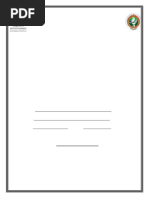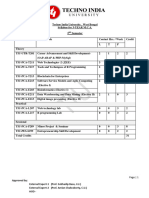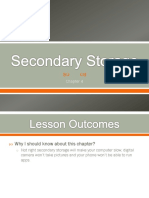CT506A-N Advanced Java Programming
Uploaded by
Kush PrajapatiCT506A-N Advanced Java Programming
Uploaded by
Kush PrajapatiKadi Sarva Vishwavidyalaya
Faculty of Engineering & Technology
Third Year Bachelor of Engineering (CE/IT)
(In Effect From Academic Year 2019-20)
Subject Code: CT506A-N Subject Title: Advanced Java Programming
Pre-requisite Object Oriented Programming with Java
Teaching Scheme (Credits and Hours)
Teaching scheme Evaluation Scheme
Total Mid Sem
L T P Total Theory CIA Pract. Total
Credit Exam
Hrs Hrs Hrs Hrs Hrs Marks Marks Marks Marks Marks
03 00 02 05 04 03 70 30 20 30 150
This course introduces the students to the advanced topics of Java Programming technology, which helps
students to prepare themselves for the industry standards and develop various business enterprise
applications as well as client-server and web applications.
Course Objective:
This course aims to
• Teach the Students for developing interactive user-friendly interfaces using the Java Swing class and
appropriate layout managers.
• Teach the database connectivity with Java programming
• Explain the enterprise architectures.
• Simulate the networking in java.
• Educate the students for developing web-based applications using Advanced Java Technologies.
Outline of the Course:
Sr. Minimum
Title of the Unit
No Hours
1 Swing 6
2 JDBC 6
3 Java Networking and J2EE 7
4 Servlets, Event Listeners and Filters 8
5 Java Server Pages and JSTL 7
6 Hibernet 4.0 7
7 Spring MVC 7
Total hours (Theory): 48
Total hours (Lab): 32
Total hours: 80
Kadi Sarva Vishwavidyalaya
Faculty of Engineering & Technology
Third Year Bachelor of Engineering (CE / IT)
(In Effect From Academic Year 2019-20)
Detailed Syllabus
Lecture Weightage
No Topic
(Hrs) (%)
Swing : JFC, MVC Architecture; difference between AWT and Swing,
Components from javax.swing package – Jcomponent, JFrame,
1 6 12
JWindow, JLabel, JButton, JTextComponent, JToggleButton,
JradioButton, JCheckbox ; Pluggable Look and Feel
JDBC: Components of JDBC; JDBC Architecture; JDBC Drivers, CURD
operation Using JDBC and java.sql package, DriverManager Class,
2 6 12
Driver, Connection, Statement and Resultset Interfaces, difference
between java.sql and javax.sql
Java Networking and J2EE : Network Programming in Java using the
java.net package; Establishing two-way communication between
3 7 15
Server and Client using TCP and UDP; Features of Java Enterprise
Edition; Architecture of Java EE; Working with EJB
Servlets : Exploring javax. servlet and javax.servlet.http packages;
Servlet Life cycle; Creating a servlet; ServletConfig and Servlet
Context objects; HttpServletRequest and HttpServletResponse
4 8 16
Interfaces; Session Tracking Mechanisms; Event Handling; Creating
and Configuring filters; Parameter initialization in Filters;
Manipulating Responses using Filter.
Java Server Pages: Introduction to JSP Technology; Architecture of
JSP (Model – I and Model - II); Life Cycle of JSP Page; Working with
basic JSP Basic Tags; Action Tags and Implicit objects in JSP; JSP
5 7 15
Unified EL; Elements of Tag extensions; Tag Extension API in Java;
Life Cycle of Simple Tag Handler; Introduction to JSTL; Core Tag
Library and XML Tag Library
Hibernate : Architecture of Hibernate; HQL; Setting up the
development environment; Creating Database Table; Writing
6 Hibernate Configuration file; JavaBean and Hibernate mapping file; 7 15
Implementing O/R mapping with Hibernate
Spring MVC : Spring Framework Architecture; Dependency Injection
8 and Inversion of Control; AOP with Spring; Managing Transactions 7 15
in Spring; Spring Form Tag Library; Spring’s Web MVC Framework
Total 48 100
Instructional Method and Pedagogy:
• At the start of course, significance of the course, content delivery pattern, and other required details
regarding subject will be discussed.
• Lectures will be conducted with the aid of multi-media projector, black board, OHP etc.
• Attendance is compulsory in lecture and laboratory which will be reflected in Continuous Internal
Assessment (CIA) component in the examination scheme of the course.
• Assignments based on the course content will be given to the students and will be evaluated at regular
interval evaluation.
Kadi Sarva Vishwavidyalaya
Faculty of Engineering & Technology
Third Year Bachelor of Engineering (CE / IT)
(In Effect From Academic Year 2019-20)
• The course includes a laboratory, where students have an opportunity to build an appreciation for the
concepts being taught in lectures. Experiments shall be performed in the laboratory related to course
contents.
Learning Outcome:
On successful completion of this course, the student should be able to:
• Implement the solution of a real time problem definition using Java Technology.
• Make them prepared with the current industry standards.
e-Resources:
• https://onlinecourses.nptel.ac.in/noc19_cs07/
• https://www.tutorialspoint.com/spring/
• https://www.tutorialspoint.com/hibernate/
• https://www.javatpoint.com/java-tutorial/
• https://www.edureka.co/blog/advanced-java-tutorial/
Reference Books:
1. Java Server Programming Java EE 7 (J2EE 1.7) Black book, Kogent Learning Solutions Inc.,
DreamTech Publication.
2. Java: The Complete Reference, 10th Edition, by Herbert Schildt, McGraw-Hill.
3. Advance Java Technology, by M.T. Savaliya, Kogent Learning Solutions Inc., DreamTech Publication.
4. Advanced Java Programming, by Uttam Kumar Roy, Oxford University Press.
List of experiments:
No Name of Experiment
1 Create a simple calculator application using Swing in Java
2 Implement Student information system using JDBC
a. Create chat application using TCP protocol.
3
b. Create chat application using UDP protocol.
4 Develop an EJB application to store and retrieve the student record.
a) Write a Servlet to display “Welcome to LDRP” on browser.
b) Write a Servlet that will fetch the header information and parameter values from the
5 header and print it on the webpage
c) Create a Servlet that implements ServletContextAttributeListener interface such that a
message dialog is displayed whenever an attribute is added or removed or replaced.
Write a servlet that counts the number of times that web page is visited and displays the
6 same information on that page.
Assume that the information regarding the salary and age for all employees of an
organization are available in a database. Develop a Servlet application which takes the
7 employee id of an employee as a request parameter and displays the marksheet for the
student.
Kadi Sarva Vishwavidyalaya
Faculty of Engineering & Technology
Third Year Bachelor of Engineering (CE / IT)
(In Effect From Academic Year 2019-20)
Write a Servlet for an online shopping website, where the customer registers himself with his
name and email- id. The continue button will be available on that page and each subsequent
8 page, which displays the list of items. The customer will choose the items and the required
quantity. In last webpage the customer’s name, email id, the list of his purchased items and
the bill amount is shown. The students are advised to make the use of cookies.
9 Create a servlet filter that adds the request processing time in the response page.
Create a Login application using servlet and JSP, where the user will provide his login details
in a servlet page and if the login is successful then, a JSP page with “Welcome” message and
“Log Out” button should be shown. If the login is failed, then message of failure and link to
10
further login should be shown on a JSP page. If the failure count reaches to 3 then the
webpage should be closed. The students are advised to make use of session tracing
mechanisms.
a) Create a web page that prints 1 to 10 using JSTL 8.2
11 b) Create a custom JSP tag that prints current date and time. Use this tag into JSP page.
12 Create a hibernate application for employee payroll system.
13 Create a “Hello World” application using Spring MVC framework.
14 Create an online appointment booking application using Spring Web MVC framework
You might also like
- Java Algorithms for Beginners: A Practical Guide with ExamplesFrom EverandJava Algorithms for Beginners: A Practical Guide with ExamplesNo ratings yet
- 01CE0411 - Advance Java Technology - SyllabusNo ratings yet01CE0411 - Advance Java Technology - Syllabus3 pages
- Gujarat Technological University: Bachelor of Engineering Subject Code: 3160707No ratings yetGujarat Technological University: Bachelor of Engineering Subject Code: 31607074 pages
- EContent 7 2023 10 25 14 03 57 01CE0308ADVANCEJAVATECHNOLOGYpdf 2023 07 11 12 14 10No ratings yetEContent 7 2023 10 25 14 03 57 01CE0308ADVANCEJAVATECHNOLOGYpdf 2023 07 11 12 14 104 pages
- Gujarat Technological University: W.E.F. AY 2018-19No ratings yetGujarat Technological University: W.E.F. AY 2018-193 pages
- 01CE0502AdvancedJavaProgrammingpdf 2020 07 03 15 59 18No ratings yet01CE0502AdvancedJavaProgrammingpdf 2020 07 03 15 59 187 pages
- Cse4019 Advanced-Java-Programming LP 1.0 1 Cse4019No ratings yetCse4019 Advanced-Java-Programming LP 1.0 1 Cse40193 pages
- Autonomous Institution Affiliated To VTU, BelgaumNo ratings yetAutonomous Institution Affiliated To VTU, Belgaum1 page
- TY BCA (Sci) Sem V Syllabus - 06.062018No ratings yetTY BCA (Sci) Sem V Syllabus - 06.06201824 pages
- Cse1007 Java-Programming Eth 1.0 52 Cse1007No ratings yetCse1007 Java-Programming Eth 1.0 52 Cse10073 pages
- Advanced PRG Syllabus - Jan April 2013 V6No ratings yetAdvanced PRG Syllabus - Jan April 2013 V65 pages
- Java-J2Ee: Object-Oriented Programming (OOPS) ConceptsNo ratings yetJava-J2Ee: Object-Oriented Programming (OOPS) Concepts12 pages
- Java Programming (R17A0507) Lecture Notes B.Tech Ii Year - Ii Sem (R17) (2018-19)No ratings yetJava Programming (R17A0507) Lecture Notes B.Tech Ii Year - Ii Sem (R17) (2018-19)50 pages
- DAC School TG Web-Based Java ProgrammingNo ratings yetDAC School TG Web-Based Java Programming5 pages
- Java Fundamentals Made Easy: A Practical Guide with ExamplesFrom EverandJava Fundamentals Made Easy: A Practical Guide with ExamplesNo ratings yet
- Mastering the Craft of JAVA Programming: Unraveling the Secrets of Expert-Level ProgrammingFrom EverandMastering the Craft of JAVA Programming: Unraveling the Secrets of Expert-Level ProgrammingNo ratings yet
- C Programming Quiz 9 - Structure, Bitfield, UnionNo ratings yetC Programming Quiz 9 - Structure, Bitfield, Union10 pages
- Top 20 Essential ESXCLI Commands You Need To KnowNo ratings yetTop 20 Essential ESXCLI Commands You Need To Know20 pages
- University of Waterloo Midterm Examination Solutions: Marking Scheme (For Examiner Use Only)No ratings yetUniversity of Waterloo Midterm Examination Solutions: Marking Scheme (For Examiner Use Only)14 pages
- Madhava Rao Gunturu - Senior Java DeveloperNo ratings yetMadhava Rao Gunturu - Senior Java Developer5 pages

























































































